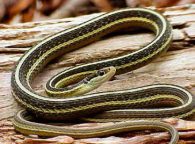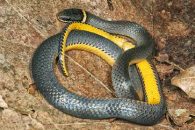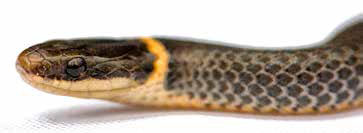by Terry McNamara
In last year’s newsletter we discussed the two most common snakes that you are likely to encounter on our island: the Northern Black Racer and the Eastern Garter Snake. There are two other species of snake that inhabit Fishers Island. You may have encountered the Eastern Ribbon Snake (Thamnophis s. sauritus). It closely resembles the ubiquitous eastern garter snake as the ribbon snake is a slender, medium-sized snake with three well-defined yellow stripes on a dark, brown to black body. It is found in a variety of habitats but always in proximity to shallow water. Like the eastern garter snake, the eastern ribbon snake is one of the first to appear in the spring and stays active April to October. They are semi-arboreal, often found in bushes and shrubs, and are active during the day.
 To determine that you are observing a ribbon snake as opposed to a garter, you can use specific keys and a general sense of their markings and relative proportion. On the ribbon snake the supralabials (the first row of scales above the mouth) are white and tend to be set off from the brown head by a thin black line. The garter snake, by contrast, often has dark bars on its supralabials (see above figure left). The lateral stripes of the ribbon involve scale rows 3 and 4 as opposed to 2 and 3 in the garter snake (see above figure right), but you’d have to handle the snake to make this observation. Once you’ve seen a few of each type, it’s easier to tell the difference. The ribbon snake is much slimmer and has a much longer tail, about a third of its body length. Its markings are much “neater” and more distinct. The ribbon snake is also swifter and more agile than the garter.
To determine that you are observing a ribbon snake as opposed to a garter, you can use specific keys and a general sense of their markings and relative proportion. On the ribbon snake the supralabials (the first row of scales above the mouth) are white and tend to be set off from the brown head by a thin black line. The garter snake, by contrast, often has dark bars on its supralabials (see above figure left). The lateral stripes of the ribbon involve scale rows 3 and 4 as opposed to 2 and 3 in the garter snake (see above figure right), but you’d have to handle the snake to make this observation. Once you’ve seen a few of each type, it’s easier to tell the difference. The ribbon snake is much slimmer and has a much longer tail, about a third of its body length. Its markings are much “neater” and more distinct. The ribbon snake is also swifter and more agile than the garter.
Eastern ribbon snakes average about 26 inches in length, though they do grow all through their lives and have been recorded up to 38 inches. The young are born in August in a litter of 2 to 20 snakes averaging 8 inches long. As an adult, the snake feeds primarily on amphibians. Most feeding is done in the morning or early evening, when the snakes prowl for food. Once the prey is discovered, the ribbon snake crawls rapidly after it, seizes it in her mouth, and swallows it.
Many wading birds and small mammals eat this snake, as do black racers and turtles. The species is considered a very good indicator of high quality wetlands because of its dietary requirements. Due to their habitat preferences, road mortality is not significant. When first disturbed, this snake attempts to escape by diving into water and swimming away or vanishing into the vegetation. When handled, they will thrash about and spray feces and musk from their anal glands, but they rarely bite.
The final member of our exclusive Fishers Island serpentine group is the Northern Ring-necked Snake (Diadophis punctatus edwardsii). This handsome 10 to 14 inch snake is smooth scaled with a slate gray or blue gray body. It has a black head, a yellow, golden or orange neck ring, and a yellowish underside. Your chances of observing this creature while walking the trails are slim, for although they are common, they are very secretive.
The snake is principally nocturnal. During the day it can be found under rocks, logs, bark or debris—but mostly under rocks. They use heated rock for thermoregulation in lieu of basking in the sun like the larger snakes. They’re often communal, so when you turn over rocks there’s a good chance there will be more than one present. They prefer woodlands and are rarely found more than a few meters from them. A walk on dirt roads in forested areas will often yield carcasses flattened by automobiles during the night.
Ring-necked snakes emerge from hibernation toward the end of April and mate soon afterwards. The female lays a clutch of 2 to 10 white elongate eggs, 7/8 inches long with a diameter of 1/5 of an inch, with one end tapering more than the other. The newly hatched young average about 5 inches and, as with all snakes, will continue to grow their whole lives, which can last up to 10 years. The record length for a ringnecked snake is over 27 inches.
A ring-necked snake feeds on salamanders, frogs, other snakes, slugs, insects, and earthworms. It seizes the prey in its mouth and chews on it until it stops struggling. Although they are completely harmless to humans, ring-necks do have a weak venom. They use their enlarged back teeth to introduce the toxic saliva into the prey. These snakes rarely bite when handled but will release an offensive smelling musk and feces when disturbed. Like all small snakes, ring-necks are viewed as a food source by a large variety of predators.
Hopefully you will encounter some of these snakes during your explorations this summer. If you do discover a clutch of eggs please report it to the Museum by email or phone call.




